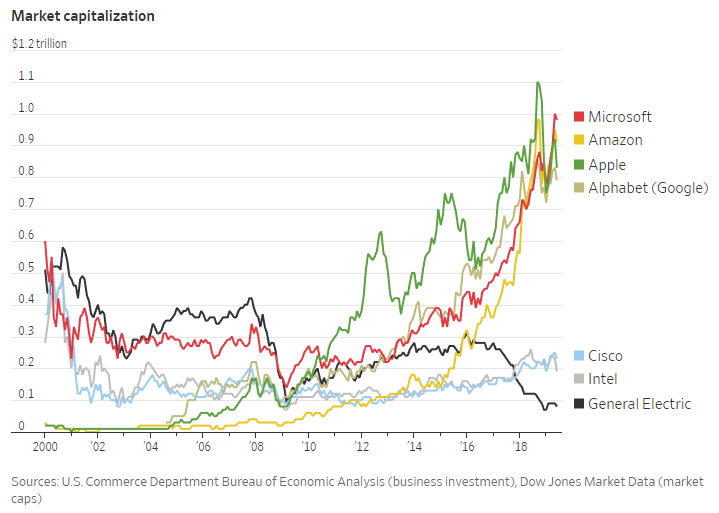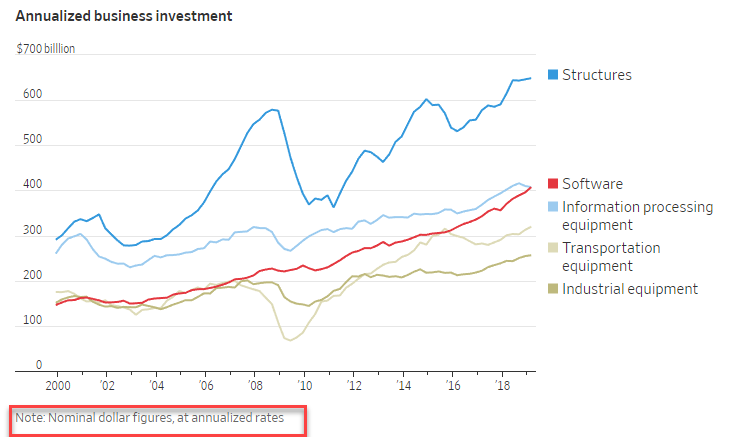Eight years ago, Marc Andreessen wrote that “software is eating the world.” Notably, he wasn’t specific about what geographies it had already consumed and where it was going next.
Today I’d like to suggest that whether this software feast is going to be good for you (winners will be dining at the software buffet)) or bad for you (the things software is eating) depends on scale and on speed. Your scale and your speed, that is.
Let’s begin with some market cap data, courtesy of the invariably reliable Greg Ip of The Wall Street Journal. Nearly 20 years ago during the reign of the dot-com’s the most valuable companies in the US were Cisco, GE, Intel, and Microsoft, all pretty much neck and neck in value. Today the most valuable company is Microsoft. Cisco + GE + Intel combined are worth less than half as much. In other words, value today attaches to and flows from software, not network and computer hardware or buildings and equipment.
Business is following the money. Here in real (inflation-adjusted) dollars is annual business investment in the major categories of capital spending. Over that same two decade period, real spending on software has nearly tripled, that on hardware grown only about 30%:
So where does not-your-father’s-Microsoft fit into this? Its cloud-based services, “Azure,” account for half its revenue today, up from not meaningful as recently as five years ago. Cloud-based services can turbocharge productivity, if you have the scale to take advantage of them. For example, Starbucks used to update the software in its 30,000 stores by distributing USB thumb drives to each of them. Today it all comes from Azure, which also monitors machines for predicted maintenance needs in real time and customizes customer recommendations on the Starbucks app using machine learning built on everything from the customer’s purchase history to the weather.You can see the question this poses to your local barista-owned coffee shop: How do we compete with that? It’s true that your genuine neighborhood barista will start your regular order when you walk in without your needing to say a word–just as, come to think of it, the regular counterpeople at the Starbucks a block and a half from my office will do. But what about the medium-size coffee chain, not Starbucks by a long shot but not truly rooted in any particular neighborhood? Sounds like an awkward place to be.
Much of the problem comes down to scale. The cloud giveth, but the Big Boys’ ability to customize it even further taketh away:
If there is a constraint on this boom, it is that software is harder to get right than hardware. Because big companies often customize or design their software in-house, their success may be difficult for others to replicate. A study by James Bessen at Boston University found that companies that invest more in proprietary information technology enjoy faster profit growth, higher revenue per employee and wider profit margins. Smaller firms struggle to compete against those advantages, which Mr. Bessen says is why economic activity has become concentrated in fewer firms.
Cloud computing could alter that equation by extending capabilities currently the preserve of big companies to small and medium-size firms. Libbey Inc., a Toledo, Ohio, manufacturer of wine glasses, tumblers and other tableware with 6,000 employees and six factories world-wide, is replacing multiple sales, finance and production computer systems with a single cloud-based system from Microsoft that will enable employees to see the entire company from anywhere in the world.
Libbey may not be an enormous company, but it’s listed on the NYSE (LBY) and according to its website is “the No. 1 glassware company in the Americas and one of the largest tableware suppliers in the world.” Not exactly a minnow.
And Libbey has not only started but is moving down the software highway at a decent rate of speed. Imagine a similarly sized tableware company that hasn’t even started. In other words, if (inadequate) scale doesn’t get you, slow speed will. Starbucks may have moved to Azure system-wide, but they at least started with thumb drives when they were state of the art.
One other observation about software: Customizing it to give your firm a competitive advantage takes coders. Not lawyers. (For all the ink that’s been spilled about lawyers learning to code, the reaction around Adam Smith, Esq. has always been that that notion ranks high on the short list of the most preposterous memes ever to insert itself into discourse around our industry.)
Expensive coders, whose work will never be done. Only firms of a certain scale can afford this. If you’re one of them, you probably know that. If you know you’re not, or you’re not sure, what’s your plan?






The first AmLaw firm to embrace software in a meaningful sense will have a competitive advantage. Actually embracing it, and not just embracing it on their marketing material, is going to require a culture shift and long-term financial investment that I don’t see many notoriously conservative and immediate-PPP-driven law firms making.
Anecdotally, I recently sat through a law firm pitch (at their request). I laid out what we were looking for: knowledge management, tools, process improvements, budget management, project management skills, etc. For most of the matters for which I’m looking for outside counsel, the lawyerly aptitude required to do an acceptable job is pretty low and rapidly asymptotic. We just don’t have that many “bet the company” matters. Given that, why does every firm pitch their legal expertise (which is relevant to about 5% of our work) and not their KM or business process expertise (which is relevant to 100% of our work)? Put another way, for most of our stuff, every AmLaw firm can do an adequate job on the legal merits, and additional legal skill isn’t a differentiator. But when you take away the legal skill as a selling point, their immediate go-to is on price, either offering discounts or flat fees. It strikes me that there’s a huge opportunity to use business-centric and software-heavy tools as a differentiator rather than simply relying on price. When is a firm going to see this and commit to it wholeheartedly?
To their credit, the firm made an effort, but ultimately if your organization isn’t using, at the least, PowerBI and Project/Primavera regularly internally, it’s going to be tough to pitch that as a core skill set and use as a differentiator.